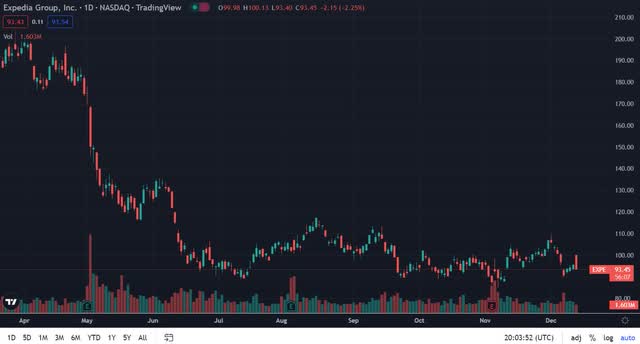400tmax/iStock Unreleased via Getty Images
Expedia Group, Inc. (NASDAQ:EXPE) generated mixed returns in its latest reporting period, producing record results in some metrics, and disappointing results in others, such as gross bookings.
According to management, it hasn’t seen any slowdown in demand for travel so far and is looking for momentum to continue heading into 2023.
Even so, it appears to me the market isn’t convinced demand is going to hold and has been trading the company in what I think is a “wait-and-see” mode. With the Fed continuing to raise interest rates, ongoing high inflation, and a recession that could turn for the worse, the leftover pent-up demand from being locked down during COVID-19 could start to wane as it costs more for consumers to use their credit cards for spending on travel.
Add to that the company’s strategy of building up a lifetime high-value customer that pays off for the longer term, makes short-term results less impressive than they otherwise may be.
In this article we’ll look at some of the recent numbers, its long-term strategy, and how investors are looking at the company at this time.
Some of the numbers
Revenue in the third quarter of 2022 was $3.6 billion, up 5 percent from the third quarter of 2019, and up 22.18 percent from the $2.97 billion in revenue generated in the third quarter of 2021.
Net income in the reporting period was $482 million, or $2.98 per diluted share, up $120 million from net income of $362 million, or $2.26 per diluted share in the third quarter of 2021.
Adjusted EBITDA in the quarter was $1.1 billion, up 26 percent from $855 million in the third quarter of 2021, and an increase of 18 percent above adjusted EBITDA in the third quarter of 2019.
Free cash flow in the quarter was negative $1.2 billion, an improvement of over $200 million above the third quarter of 2021 based upon higher EBITDA. The reason for the level of negative free cash flow was from the normal effects of seasonality. For the first nine months of 2022 free cash flow is a positive $3.1 billion, more than double the total in the third quarter of 2019.
Cash and cash equivalents at the end of the third quarter were $1.78 billion, with total liquidity of $7.1 billion from the undrawn revolver. The firm held long-term debt of $6.23 billion at the end of the reporting period.
Considering its share price to be “highly undervalued,” management says it’ll continue to return capital to shareholders via share buybacks and de-lever the balance sheet.
The company has 21 million remaining shares that it’s authorized to buy back.
Sales and marketing investment and strategy
EXPE spent $1.5 billion on direct sales and marketing in the reporting period, in alignment with its strategy of attracting lifetime, high-value customers.
While management stated analyzing the short-term results from the implementation of the strategy will be difficult to do because of the long-term time frame the company is using to measure the results; it believes focusing on channels like “brand awareness, loyalty and paid app installs are the key to driving long-term growth.”
While the company didn’t say it, I think it’s also a way of weeding out short-term investors in lieu of shareholders in it for the long haul.
When asked about consumer demand, CEO Peter Kern said EXPE hasn’t seen trade downs or changes in demand, with the exception of the temporary impact of Hurricane Ian.
The point there is Kern believes the strategy of targeting a specific type of consumer that has long-term value to the company has been part of the reason behind the ongoing demand.
As for 2023, demand remains at a strong pace, and so far the company hasn’t seen any signs that it’ll change going forward.
With that being the case so far, I think the company will continue to spend on sales and marketing at high levels in order to drive sustainable, long-term growth.
As long as the results continue, the company is unlikely to receive any resistance from shareholders, but if spend remains high and the results weaken in any meaningful way on a consistent basis, the company will be forced to reconsider its strategy.
Total gross booking concerns
There was a negative response to the drop in total gross bookings in the quarter, as they came in at $23.99 billion for the third quarter, down over $1.1 billion from consensus estimate of $25.1 billion.
The market seemed to have interpreted this as a signal demand was decreasing against the weakening macro-economic backdrop, but according to the company, it was the result of an industrywide weak July.
After the weak month demand rebounded, which suggests to me it was only a temporary blip in demand. If the weakness would have continued through August and onward, it would have been more concerning, but as it is, I think fears, for the most part, were unwarranted.
That said, gross bookings are a good metric to follow with EXPE, and any sign of continuous weakness in that area would be a confirmation that travel market demand is starting to wind down; possibly from waning pent-up demand or high credit card rates that are getting more expensive as the Fed keeps on raising interest rates.
I don’t see it being an issue now, but any linear decline in gross bookings on a consecutive monthly basis would be something to base a re-evaluation of the company on.
Conclusion
Excluding the temporary July 2022 industrywide slowdown, there has been no sign the travel sector is starting to wind down in demand. Consumers continue to prioritize travel and experiences over other discretionary expenditures, and until that changes, Expedia should continue to perform very well.
On an annual basis it throws off a lot of free cash flow, and it provides the company with flexibility on to how best to deploy capital to best reward its shareholders.
It looks like its strategy of increasing spending on sales and marketing for the purpose of attracting long-term, high-value customers is a sound one, and results should continue to reaffirm the strategy over the next couple of years.
With that in mind, the stock would be most appealing for those investors wanting to take a position with the idea of holding for a prolonged period of time. To take a position with a short-term time frame could result in losses for those not willing to wait for the impact of its strategy to take hold and produce visible results.
Lastly, just because there are no signs of slowing demand for travel, doesn’t mean it won’t happen in 2023 if the recession goes deeper for longer and consumer and businesses start to tighten up on spending.
The share price of Expedia has plunged from the time it took a hit from the pandemic in early 2020, dropping to a 5-year low of approximately $41 per share before clawing its way back to its 52-week high of $217.72. Not long afterwards it once again fell off the cliff to trade at a little under $94.00 per share as I write.
Even though the company is probably undervalued at this time, any sign that gross bookings are entering into a downward trend would push its share price downward to a very low entry point. It seems it has found a bottom of about $90.00 per share and is trading in a fairly tight range.
My belief is that that is because the market is waiting to see which way the travel sector is going to go in light of a weak economy and high interest rate environment.
Management doesn’t see any signs of slowing demand, but it seems to me investors aren’t quite buying it at this time, meaning they aren’t convinced that couldn’t change in the near future, so they appear to be in a wait-and-see mode before making further commitment to the stock.



Be the first to comment